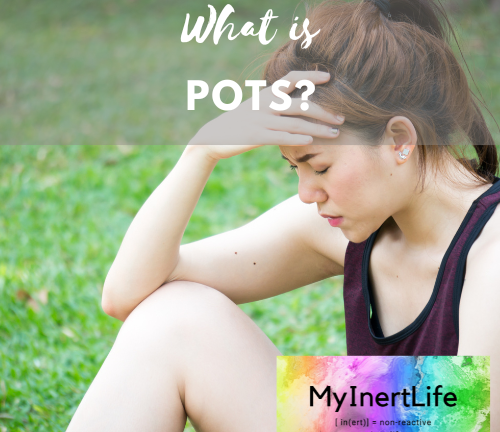Do you know how to recognize POTS and MCAS? Postural orthostatic tachycardia syndrome (POTS) is a comorbidity with Mast Cell Activation Syndrome (MCAS), meaning that they are often found occurring together. In this post, I discuss what POTS is and its relationship to MCAS.
As an Amazon Associate, I earn from qualifying purchases.
Table of Contents
POTS and MCAS
POTS and MCAS have a number of similar symptoms:
“Postural orthostatic tachycardia syndrome (POTS) is commonly found in patients with mast cell disease. However, POTS itself can have similar symptoms to mast cell disease. Palpitations, blood pressure abnormalities, sweating, anxiety, nausea, and headaches are some symptoms both POTS and mast cell disease have. There are also other forms of dysautonomia which mimic the presentation of mast cell disease.” – Mast Attack
https://www.pinterest.com/pin/1054475700229975949/What is MCAS?
Mast Cell Activation Syndrome (MCAS) is a chronic condition that affects all organ systems. MCAS is serious and disabling and people with MCAS experience often significant and debilitating symptoms daily, including anaphylaxis, which can be fatal.
MCAS is often found in combination with other chronic conditions such as Ehlers-Danlos Syndrome (EDS) and Postural Orthostatic Tachycardia Syndrome (POTS).
Frequently healthcare providers do not know about MCAS, and the tests for MCAS are problematic because they are not uniformly reliable. MCAS can be difficult to manage. Treatments include blocking mast cell mediators with anti-histamines and mast cell stabilizers, as well as avoiding triggers.
Check out this post on how to manage MCAS.
POTS defined
Many people call POTS an invisible illness because it comes with symptoms that are subjective.
“POTS is a form of dysautonomia (a dysfunction of the nerves involved in controlling involuntary bodily functions, like heart rate, blood pressure, breathing) that affects blood flow through the body. Blood flow back to the heart is decreased upon standing (orthostatic), which causes an increase in heart rate to try to correct this abnormal blood flow on the back end (tachycardia). Typically, someone has POTS if their heart rate increases by 30 beats per minute or if their heart rate exceeds 120 beats per minute within 10 minutes of standing. One of the common symptoms of POTS is dizziness upon standing, which may or may not lead to patients fainting when trying to stand up, earning POTS another nickname, the “fainting disease.” – Dr. Becky Campbell
POTS symptoms
Other symptoms of POTS include:
- Headache
- Nausea
- Abdominal pain
- Chronic pain
- Heart palpitations
- Fatigue
- Shortness of breath
- Insomnia
- Brain fog
- Sweating abnormalities
- Weakness
- Bladder dysfunction
- Tremors
Functional dehydration
Having POTS causes your body to behave as if it is dehydrated, and this issue is exacerbated by MCAS.
“Many mast cell mediators are vasoactive, affecting the permeability of blood vessels. This means that mast cell activation causes third spacing, the loss of fluid from the bloodstream to the tissues, where the body cannot use it. This functional dehydration can cause a lot of symptoms, not the least of which is exhaustion and difficulty standing or exercising. For obvious reasons, this will be further exacerbated in a patient that is deconditioning or who has also has POTS.” – Mast Attack
IV fluids for POTS
One of the common ways of treating POTS is to use electrolytes. Another promising treatment is IV fluids.
“A paper published in early 2017 reestablished the finding that use of intravenous fluids helps POTS. Treatment lengths and infusion volumes varied from person to person. Despite these variations, use of IV fluids decreased symptoms and improved quality of life for POTS patients. The link to the abstract is here.”- Mast Attack
One drawback to using IV fluids is administration. You have to either have a picc line or central line catheter and be able to administer the IV fluids at home, or you need to go to the ER to have them administered, making it a bit cumbersome.
The bucket theory
The Bucket Theory offers a helpful analogy for understanding symptom reactions with MCAS.
Think of your body as an empty bucket that you want to keep from overflowing. Different foods and activities fill your histamine bucket at different speeds but they combine to form the total level of histamine in your body (how full your bucket is). A fuller bucket means you have more histamine symptoms. When you manage triggers, reduce exposure to known triggers, and take medications and supplements to reduce histamine, you can manage the level of your bucket.
Know your typical symptom progression
One of the keys to understanding the level of your bucket is knowing your symptom progression. It is helpful to keep track of the symptoms you are having and to evaluate whether they are escalating. Symptom escalation means that the level of your bucket is rising.
Knowing your symptom progression in a symptom flare is the key to developing your own rescue plan. In this post, I discuss how to determine your own symptom progression. Once you know what typically happens in your symptom progression you can design a rescue plan to address those symptoms.
Get my free ebook, symptom tracker, and meal plan!
Want a tool to easily keep track of your symptoms? Sign up for my newsletter and you will receive my free 50-page ebook of lower-histamine, grain-free, sugar-free, Keto recipes, my free symptom log, and a free two-week meal plan!
What is dysautonomia?
Many MCAS and POTS patients also have a condition called dysautonomia.
“Dysautonomia is a condition in which your body’s autonomic nervous system doesn’t regulate essential bodily functions correctly. POTS is the most common form of dysautonomia found in mast cell patients but other forms occur, too.” – Mast Attack
The MCAS trifecta: POTS, MCAS, and EDS
And many POTS and MCAS patients also have a condition called Ehlers-Danlos Syndrome (EDS).
“Mast cell patients commonly have MCAS, EDS and POTS together. They cooccur so commonly that some experts think that that this presentation is actually one overarching disease rather than three separate ones affecting mast cell patients.” – Mast Attack
Sign up for the SSP!
The Safe and Sound Protocol (SSP) is a listening therapy based on Polyvagal Theory created by Stephen Porges to unlock your ability to think, feel, and connect better through nervous system regulation. You use the SSP via an app on your phone and listen with over-the-ear headphones to specially filtered music that heals the nervous system, specifically the vagus nerve. You subscribe to the app with a provider like me and listen to the specially curated music for 30 minutes each day for a 5-hour cycle. Studies show the SSP has a profound effect on mental health and chronic conditions
You can sign up for the SSP here!
Order my book!
Rocks and Roots chronicles my journey solo backpacking the Superior Hiking Trail and overcoming nervous system dysregulation, gut dysbiosis, and Mast Cell Activation Syndrome symptoms to hike 328 miles successfully.
Check out this powerful frequency device
Healy is an individualized microcurrent device I use to reduce inflammation. Check out this post for more about Healy.
Sign up for a session!
I provide one-on-one in-person and remote chronic illness and caregiver coaching and Sacred Self-Healing Sessions based on the Sacred Self-Healing Method, a proven novel co-creative healing modality detailed in my Books.
Click here for more information.
What do you think?
I’d love to have your reply below!
Disclaimer
The preceding material does not constitute medical advice. This information is for information purposes only and is not intended to be a substitute for professional medical advice, diagnosis, cure or treatment. Always seek advice from your medical doctor.






13 thoughts on “The Problem of POTS and MCAS”